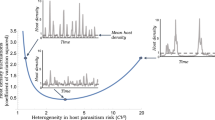Abstract
The geographic mosaic theory of coevolution suggests that population spatial structure may have a strong impact on coevolutionary dynamics. Therefore, coevolution must be studied across geographic scales, not just in single populations. To examine the impact of movement rate on coevolutionary dynamics, we developed a spatially explicit model of host–parasitoid coevolution. We described space as a coupled-map lattice and assumed that resistance (defined as the ability of a host to encapsulate a parasitoid egg) and virulence (defined as the successful parasitization of a host) traits were graded and costly. The model explicitly detailed population and evolutionary dynamics. When holding all parameters constant and varying only the movement rate of the host and parasitoid, profoundly different dynamics were observed. We found that fluctuations in the mean levels of resistance and virulence in the global population were greatest when the movement rate of the host and parasitoid was high. In addition, we found that the variation in resistance and virulence levels among neighboring patches was greatest when the movement rates of the host and parasitoid was low. However, as the distance among patches increased, so did the variation in resistance and virulence levels regardless of movement rate. These generalizations did not hold when spatial patterns in the distribution of resistance and virulence traits, such as spirals, were observed. Finally, we found that the evolution of resistance and virulence caused the abundance of hosts to increase and the abundance of parasitoids to decrease. As a result, the spatial distribution of hosts and parasitoids was influenced.
Similar content being viewed by others
References
Comins, H.N., Hassell, M.P. and May, R.M. (1992) The spatial dynamics of host–parasitoid systems. J Animal Ecol. 61, 735–748.
Dale, M.R.T. (1999) Spatial Pattern Analysis in Plant Ecology. Cambridge University Press, Cambridge, UK.
Fellowes, M.D.E., Kraaijeveld, A.R. and Godfray, H.C.J. (1998) Trade-off associated with selection for increased ability to resist parasitoid attack in Drosophila melanogaster. Proc. Royal Soc. Lond. B 265, 1553–1558.
Gandon, S. (2002) Local adaptation and the geometry of host-parasite coevolution. Ecol. Lett. 5, 246–256.
Gandon, S., Copowiez, Y., Dubois, Y., Michalakis, Y. and Olivieri, I. 1996. Local adaptation and gene-for-gene coevolution in a metapopulation model. Proc. Royal Acad. Sci. B 263, 1003–1009.
Godfray, H.C.J. (1994) Parasitoids: Behavioral and Evolutionary Ecology. Princeton University Press, NJ.
Gomulkiewicz, R., Thompson, J.N., Host, R.D., Nuismer, S.L. and Hochberg, M.E. (2000) Hot spots, cold spots and the geographic mosaic theory of coevolution. Am. Nat. 156, 156–174.
Hassell, M.P., Comins, H.N. and May, R.M. (1991) Spatial structure and chaos in insect population dynamics. Nature 353, 255–258.
Henter, H.J. (1995) The potential for coevolution in a host–parasitoid system. II. Genetic variation within a population of wasps in the ability to parasitize an aphid host. Evolution 49, 439–445.
Henter, H.J. and Via, S. (1995) The potential for coevolution in a host–parasitoid system. I. Genetic variation within an aphid population in susceptibility to a parasite wasp. Evolution 49, 427–438.
Hochberg, M.E. (1997) Hide or fight? The competitive evolution of concealment and encapsulation in parasitoid–host associations. Oikos 80, 342–352.
Huffbauer, R.A. (2001) Pea aphid–parasitoid interactions: have parasitoids adapted to differential resistance? Ecology 82, 717–725.
Huffbauer, R.A. (2002) Evidence for nonadaptive evolution in parasitoid virulence following a biological control introduction. Eco. Appl. 12, 66–78.
Huffbauer, R.A. and Via, S. (1999) Evolution of an aphid–parasitoid interaction: variation in resistance to parasitism among aphid population specialized on different plants. Evolution 53, 1135–1145.
Kraaijeveld, A.R. and Godfray, H.C.J. (1997) Trade-off between parasitoid resistance and larval competitive ability in Drosophila melanogaster. Nature 389, 278–280.
Kraaijeveld, A.R. and Godfray, H.C.J. (1999) Geographic patterns in evolution of resistance and virulence in Drosophila and its parasitoids. Am. Nat. 153, S61–S74.
Kraaijeveld, A.R. and Godfray, H.C.J. (2001) Is there local adaptation in Drosophila-parasitoid interactions? Evol. Ecol. Res. 3, 107–116.
Kraaijeveld, A.R., Hutcheson, K.A., Limentani, E.C. and Godfray H.C.J. (2001) Costs of counterdefenses to host resistance in a parasitoid of Drosophila. Evolution 55, 1815–1821.
Kraaijeveld, A.R. and Van Alphen, J.J.M. (1995) Geographical variation in encapsulation ability of Drosophila melanogaster larvae and evidence for parasitoid-specific components. Evol. Ecol. 9, 10–17.
Lapchin, L. (2002) Host–parasitoid association and diffuse coevolution: when to be a generalist? Am. Nat. 160, 245–254.
Lively, C.M. (1999) Migration, virulence and the geographic mosaic of adaptation by parasites. Am. Nat. 153, S34–S47.
Nuismer, S.L., Thompson, J.N. and Gomulkiewicz, R. (2000) Coevolutionary clines across selection mosaics. Evolution 54, 1102–1115.
Sasaki, A. and Godfray, H.C.J. (1999) A model for the coevolution of resistance and virulence in coupled host–parasitoid interactions. Proc. Royal Soc. Lond. B 266, 455–463.
Speith, P.T. (1979) Environmental heterogeneity: a problem of contradictory selection pressures, gene flow and local polymorphism. Am. Nat. 113, 247–260.
Strand, M.R. and Pech L.L. (1995) Immunological basis for compatibility in parasitoid host relationships. Ann. Rev. Entomol. 40, 31–56.
Tiën, N.S.H., Boyles, D., Kraaijeveld, A.R. and Godfray, H.C.J. (2001) Competitive ability of parasitized Drosophila larvae. Evol. Ecol. Res. 3, 747–757.
Thompson, J.N. (1999) Specific hypotheses on the geographic mosaic of coevolution. Am. Nat. 153, 1–S14.
Thrall, P.H. and Burdon, J.J. (2002) Evolution of gene-for-gene systems in metapopulations: the effect of spatial scale of hosts and pathogen dispersal. Plant Pathol. 51, 169–184.
Author information
Authors and Affiliations
Corresponding author
Rights and permissions
About this article
Cite this article
Sisterson, M.S., Averill, A.L. Coevolution across landscapes: a spatially explicit model of parasitoid-host coevolution. Evolutionary Ecology 18, 29–49 (2004). https://doi.org/10.1023/B:EVEC.0000017692.23250.d1
Issue Date:
DOI: https://doi.org/10.1023/B:EVEC.0000017692.23250.d1




